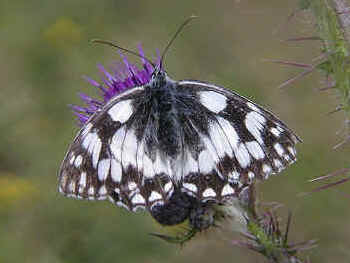
MEADOWS
Meadow Animals

Marbled White Butterfly
| High plant diversity in meadows more or less
guarantees that there will also be a great diversity of animals. A variety of herbivores
will be on hand to consume all the different plant species and they in turn will supply
food for any number of carnivores from spiders to beetles, birds and foxes. It is not just the diversity which is remarkable but the also the sheer numbers of animals involved. The following estimations have been made:
These numbers of invertebrates are possible because there are an enormous number of microhabitats within the meadow. The grasses provide the structure in the meadow, giving rise to a number of different layers.
Lower down, the leaves and stems of grasses and other plants provide food for caterpillars and other herbivorous animals. Still further down, the dead tussocky bases of perennial grasses and the accumulation of leaf litter provide shelter and food for springtails, mites and woodlice. Beneath this is the world of the soil, which is again seething with life, from earthworms to moles. In just one acre of soil it has been calculated that there are no less than 400 million insects and 600 million mites! Invertebrates of Meadows There are so many invertebrates present in meadows that it is possible to single out only a few for special mention.
Summer hay meadows with tall grasses may be alive with clouds of Meadow Brown, Marbled White and Large Skipper Butterflies. The caterpillars of all these butterflies feed on specific species of native wild grasses. The intensively cultivated silage and pasture fields of modern agriculture consist of cultivated grasses which are not suitable food plants. In any case, the intensive cutting, or grazing regime would preclude the butterflies being able to complete their life cycles successfully, even if suitable grasses were present. In wet or water meadows, the butterflies are more likely to be species such as Orange-tips, feeding on Lady's-smock, and Marsh Fritillaries nectaring on Meadow Thistles.
Grasshoppers and Bush-crickets are another feature of meadows. Grasshoppers are almost all completely herbivorous, feeding mainly on grasses. As their name suggests, Meadow Grasshoppers are likely to be one of the commonest species. With their cryptic colouration, grasshoppers are difficult to spot amongst the grasses. Their chirping signals to each other, made by rubbing their hindlegs and forewings together, advertise their presence and provide part of the background hum of the meadow. Other insect herbivores include bugs such as the frog-hoppers, probably more familiar to most of us as 'cuckoo spit', which is the foam surrounding nymphs of these bugs. The foam prevents them from drying out and gives them some protection from predators. Moving down towards soil level, heaps of soil on the meadow surface might betray the presence of moles, feeding on the rich earthworm populations in meadow soils. Alternatively, larger heaps may indicate the presence of Meadow Ants (Lasius flavus). These ants farm the field in their own way by cultivating aphids. The ants shelter and protect root-feeding aphids, which in return excrete honeydew which the ants feed on. The soil itself will also contain a number of other invertebrate species which feed on the roots of the meadow plants. These include animals such as leatherjackets and wireworms, which are the larvae of Crane flies, and Click Beetles respectively. There are any number of invertebrate predators in the meadow, from spiders, to large numbers of ground beetles.
The invertebrates in the meadow may be further swelled by those inhabiting what most of us would consider to be an unusual habitat - the dung of cattle and sheep grazing the meadows.
|